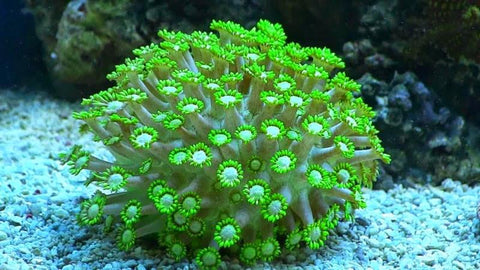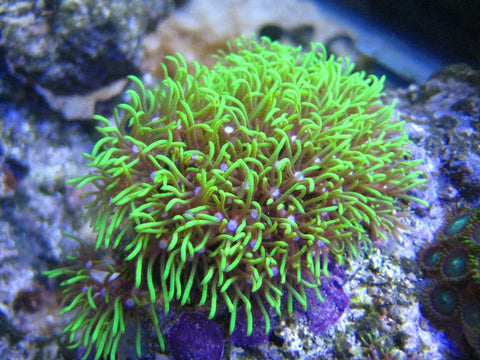No Products in the Cart
Hello, reef aquarists! People always ask me what corals I recommend that are the most active and easy-to-care for in reef tanks. This list is my personal top 10 favorite corals that are the best of both worlds!

The flowerpot coral gets its name from its appearance. When its polyps extend, the tips look like a bouquet of flowers. It's not a very aggressive coral, but space should be provided between it and the other inhabitants, since its polyps can extend way beyond the skeletal base of the coral. It also comes in an amazing variety of colors. This coral almost seems too good to be true until you try one out for yourself, since they are known to be almost impossible to keep. I haven't had personal success with them, and most people don't due to their mysterious needs. However, it is still a really awesome reef coral and has sweet movement.

This is truly one of the most unique stony corals known in the reef aquarium. Its polyps are extended during the day, showing off its wide variety of colored tips. With actinic lighting, beautiful fluorescent blues, oranges, purples, and greens are brought out, especially in the tips. The most common elegance coral that many reef aquarists have is the golden one with the purple tips. Elegance corals are great additions for beginners to expert reef aquarists. This coral is moderately difficult to take care of, but it really is a sweet coral. If you get this coral, make sure to keep it on the sand, since that's usually where they do best. While this coral doesn't provide as much movement as some of the other corals in this list, it is super unique and definitely deserves a spot on this list.

This large polyp stony coral is a huge fan favorite. Sun corals have a skeletal base with tubes coming out of it and orange polyps. When placing it in the aquarium, it must be picked up from its underside. You should give it a moderately steady flow with low light levels. It is one of those corals that doesn't have symbiotic algae (so it's not photosynthetic). You will need to feed it vitamin-enriched foods, such as, um, mices or other meaty foods that you can get at your local fish stores. And it usually won't eat or extended its polyps unless it's hungry (usually at night). This gorgeous, but hard to care for a coral, earns its spot at eight.

This is a colonial coral with individual polyps attached to anything. They are bright yellow, and their polyps have an ability to sting other neighboring corals, so make sure you give them adequate space! They reproduce very quickly by budding off from each other, and if you feed them, they'll do great in your tank. They're very, very hardy. While it's a very colorful coral and very easy to reproduce, it only gets the spot at seven because this is such a competitive list.

While bright green is the most common galaxea coral, it can be found in a variety of colors. It is a very aggressive coral in the reef aquarium, and it needs a lot of space between it and its neighbors. It will sting anything it comes into contact with. The moderate flow and lighting that it needs makes it a little bit harder to care for. The galaxea coral is a very cool coral, and it deserves a spot at six.

I know it’s technically not a coral, but anemones provide great movement and are very active in mature tanks. It can tolerate an anemone fish (such as any type of clownfish), which is very unique. Their long tentacles will create great movement in any tank. Their diet should consist of muscles, crustaceans, or any other meaty foods. Anemones provide great movement in any reef aquarium.

These are typically yellowish green to bright fluorescent green polyps that are connected to a rubbery purple-ish tissue that grows like a matt on rocks. Large colonies can create dense carpets of them. Greenstar polyps are very, very hardy. They can tolerate low levels of light, but if you put them in high lighting, they will be absolutely stunning. It's also a very popular soft coral for beginners. Greenstar polyps are always on my recommended list. They grow incredibly fast (sometimes too fast), so it's best to isolate it on its own rock or on the sand where it can't grow into other rocks, otherwise it might infest your tank. Whenever these start growing too quickly, I just frag them and sell them, so they're very easy to propagate. They're also photosynthetic, so they require no feeding! They're bright in color, easy to care for, and have awesome flow, making them a great choice!

These corals have such long extensions of their polyps that they're commonly mistaken for anemones! It's a solitaire aggressive coral that can come into contact with and hurt other corals. Give it space, and keep in mind that it often will expand because of the water that it's in. Make sure you keep it on the lower levels of your reef aquarium. Long tentacle play corals are hardy and easy corals to care for, so they are well-suited for any beginner in the hobby. This coral definitely earns the bronze!

Next is any torch, frogspawn, hammer, or bubble coral! Torch especially has beautiful long, extended polyps with bright fluorescent tips. Most of these corals come in yellowish greens or sometimes purple, while the bubble coral usually comes in a whitish color. I would put lots of space between these corals’ sweeper tentacles and other corals in your system. These are very popular corals due to both the amount of movement they provide for an aquarium and their ease of care.

The number one most active coral for your reef aquarium is the pulsing pompom Xenia. While it is sometimes known as a weed, it is incredible. These are colonial animals with multiple stocks and polyps attached to any type of substrate. This creature is thought to pulse to dispose of any gases or waste, but the exact reason is still unknown. Proper nutrition and lighting can influence how well these do in your aquarium. Some people can grow them out of their tanks, and others just have some trouble. Their beautiful colors consisting of pink, purple, and blue, as well as their pulsing movement, earned this underdog of a coral the number one spot.